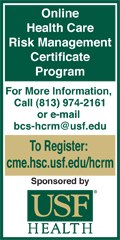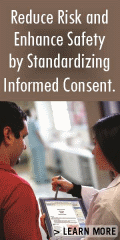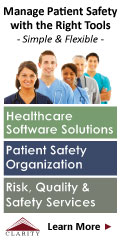 |
 |
 |

March / April 2008

Conflict Management From the Heart:

A Day in the Life of a Medical Ombuds/Mediator
They wanted to know why it happened, if there was anything that could have been done to prevent their son's death, and, if so, what the physicians and hospital were doing to prevent something like this from happening again.
By Carole S. Houk, JD, LLM,

and Leigh Ana Amerson, BA
Conflict management comes in many forms — practitioners can be mediators, facilitators, >arbitrators, attorneys, ombuds, coaches — the field is constantly evolving. One recent innovation in healthcare is the introduction of a highly skilled individual who is trained in mediation, facilitation and coaching techniques while serving functionally as an organizational ombuds, or internal neutral resource. Providing a confidential, neutral, and independent resource to both patients and providers, a medical ombuds/mediator can help to resolve the inevitable conflicts that arise around unanticipated adverse outcomes at the point of care. With disclosure policies now mandated by JCAHO, the focus is turning to what happens after disclosure. When an unanticipated adverse outcome does occur, how healthcare providers choose to respond to that adverse event will have powerful repercussions for all parties concerned. What follows is a fictional yet representative case handled by a medical ombuds/mediator.
"Hello, I think I need your help — do you have a moment?" The male voice sounded shaky and distant — not at all like the confident surgeon I was expecting when I glanced at the caller ID. I assured him I had all the time he needed and gently said, "I'm here for you." There was a long pause before he began to speak. Slowly, hesitantly, Dr. Greene said, "One minute, everything was fine, and now I have to go out into the waiting room and tell this boy's parents that their only child died during surgery."
I can't help but hear how devastated Dr. Greene is by the loss of his patient, and realize how difficult it will be for him to tell the parents. At this point, not only do I need to assist Dr. Greene as he prepares to meet with the parents, but I also mourn the loss for the parents who do not yet know their child has died. I ask how Dr. Greene and the surgical team are doing and acknowledge their loss of so young a patient. Dr. Greene shares that the boy had been his patient for several years and that he had weathered a few clinically challenging times with this young family given the child's medical history. Finally, the question I anticipate comes, "How am I going to tell them he died, when I don't know why? What do I say?"
I share with Dr. Greene that we should always provide compassionate, open, and honest communication. The parents will be receiving emotionally devastating news and will want compassion and transparency. They will feel a myriad of emotions simultaneously and will want answers. They will want the truth. They may want someone to blame. Most importantly, they will need and expect acknowledgement of their loss, assurance that Dr. Greene and the hospital share their need to know what happened and why, and, in the event that an error occurred, what will be done to assure that it won't happen again. In other words, the parents will want to know if the physician and the hospital will do the right thing.
As a medical ombuds/mediator, I realize that while preparing for any difficult conversation is critical, when involving an unanticipated adverse event such as the loss of a child, the conversation will be extremely difficult and life altering. Preparation for the initial disclosure conversation doesn't end with the disclosure, however, but takes into consideration what happens after this first conversation. I offer to make arrangements for the parents and Dr. Greene to meet in an appropriate, quiet setting and inquire if it would be beneficial for me to meet with the parents afterwards. Dr. Greene agrees that by framing a thoughtful, compassionate response and providing an appropriate outreach to the parents at one of the most vulnerable and challenging times in their lives, we can prepare to answer their questions and meet their needs surrounding the loss of their child. Gently, I let him know again that he won't be alone as we move down this difficult path.
Shortly after our telephone conversation, Dr. Greene met with the devastated parents, Mr. and Mrs. Franks. As we discussed, Dr. Greene expressed his condolence for their loss and shared with the parents the few facts that were known at this time. Most importantly, Dr. Greene assured them that he would continue to share information as it became available and asked permission for me to meet with both of them.
I met with Mr. and Mrs. Franks immediately after Dr. Greene left the room and offered my condolences for their loss. I briefly shared with them my role as medical ombuds for the medical center and inquired if they needed anything and if they had any questions at this time. Understandably, the Franks were still in shock. I asked permission to contact them in a few days, and to please contact me if they needed anything. Realizing that they needed time alone to grieve, I turned to quietly leave, but stopped when Mrs. Franks asked me, "What next? What do we do now?" Following the guidance I had shared with Dr. Greene earlier, I sat down beside her as she began to talk about her son, Joey. I listened for a while, and when she was ready to say goodbye, we agreed to speak again in a few days. I used this opportunity to assure them that as information became known, it would be shared. They both wanted the assurance that open and honest communication would continue and that "walls" wouldn't go up, and that nothing regarding the events leading to Joey's death would be "hidden" from them.
The week after Joey's funeral, I made another outreach to the Franks. Enough time had passed to surface questions and they were ready to hear what happened without the initial shock of the loss of their son. They wanted to know why it happened, if there was anything that could have been done to prevent Joey's death, and, if so, what the physicians and hospital were doing to prevent something like this from happening again. They especially wanted to know if there was anything that they weren't being told. To facilitate the Franks' objectives to obtain answers to their questions, I offered to arrange a meeting with Dr. Greene to talk about the surgery and what was known surrounding Joey's death. They agreed to the meeting, and I let them know that I would work with Dr. Greene to schedule it for the following week.
The meeting was emotionally draining for everyone. However, the Franks were assured that they would not have to overcome barriers to information and that communication was being shared regarding the loss of their son. Dr. Greene was transparent in his shared quest for the truth. In meeting with the Franks, Dr. Greene established trust with the parents by showing his willingness to share information through compassionate, open, and honest communication.
As Dr. Greene and I debriefed the family meeting, he shared how encouraged he felt afterward due to the open, honest, and timely communication shared by everyone. He appreciated receiving assistance in the form of my "just in time" coaching and felt that the Franks received information instead of experiencing barriers that sometimes are erected when information is not known, but fears of possible negligence lie under the surface. He felt that the meeting went well and that the Franks did not harbor feelings of frustration or anger because of the timely response to their questions regarding the loss of their son. Dr. Greene agreed that by reaching out to the family initially, whether there was negligent involvement or not, provided the opportunity for critical questions to be answered as thoroughly as possible with compassion.
My subsequent outreach to the Franks was equally validating. Our conversation provided another opportunity to assure them that as additional information became known, it would be shared with them in a timely and honest manner. The Franks realized that it may be several weeks or possibly months before further information is known as a result of informal and formal investigations, but through open, honest and compassionate communication, we are working together to reestablish trust even after the devastating loss of Joey.
Several weeks have now elapsed. Dr. Greene called this morning to ask me to facilitate a meeting with the Franks to disclose some additional information regarding Joey's death. It has been determined that Joey's death was attributable to a rare anesthesia error. Realizing that this might have been a preventable medical error, Dr. Greene asks for my help in preparing for the disclosure conversation, and wonders whether he should apologize directly, involve the anesthesiologist, bring in legal counsel, or . . . just what are his next steps?
In preparing my response to Dr. Greene's questions and hearing the concern in his voice, I reflect on my role as a medical ombuds/mediator for the medical center. An underlying rationale for early and transparent responses to adverse outcomes can be linked to numerous studies that found that ineffective communication with patients and families, rather than quality of care, was the underlying cause of patients' and families' decisions to file suit against their caregivers (Vincent et al., 1994; Hickson et al., 1992). Other researchers found that most patients would be less angry and less likely to sue if physicians honestly and compassionately disclosed medical errors that occurred, admitted responsibility, took steps to reduce the chances of repeat errors in the future, and offered sincere apologies for the suffering that may have resulted because of the bad outcomes (Gallagher et al., 2003). Similarly, research on apologies suggests that individuals receiving a full apology that both expresses sympathy and takes responsibility by the person who wronged them are more likely to accept settlement offers and negotiate towards a resolution rather than going to trial (Robbennolt, 2003).
When contacted in a timely way by knowledgeable healthcare staff, I can intervene early at the lowest possible level and attempt to resolve disputes that could potentially result in malpractice claims, with the overarching purpose of improving patient and family satisfaction, quality of care, patient safety, and systemic performance. An intended side effect is to help eliminate miscommunication that compromises the ability of the hospital to render excellent patient care (Houk & Moidel, 2003). Established functionally as an organizational ombuds skilled in conflict management techniques such as facilitation, coaching, and mediation, I provide a neutral, independent, and confidential resource to assist patients, families, and providers in addressing concerns about unanticipated adverse outcomes, medical errors, provider-patient communication breakdowns, and dissatisfaction with treatment outcome or quality of care (Bonacum et al., 2004). I have been fully trained as an organizational ombuds, mediator, and facilitator, and can readily coach or assist providers in conversations with patients and families where emotions run high and where an apology may be in order. Personal acknowledgement of the pain and suffering that individuals are going through is often a starting point for my engagement as both informal and formal investigations begin to ascertain causality. Information is shared as it is obtained, and conjecture and uncertainty are kept to a minimum (Joint Commission, 2007).
My role as a designated neutral party within the organization permits individuals to acknowledge error in a way that maximizes confidentiality and security, helps to pinpoint system vulnerabilities, and encourages collaboration among healthcare professionals to prevent further error by promoting a culture of safety (Studdert et al, 2006). I have dozens of colleagues at medical centers across the country who serve in this role, offering more equitable and integrative solutions to injured patients and their families after an unanticipated outcome has occurred (Joint Commission, 2007; Kiger, 2004; Walker, 2006; Woods, 2007).
Marshalling my resources, I turn back to my conversation with Dr. Greene. "Doctor," I say, "let's plan to meet tomorrow to brainstorm for this upcoming meeting. We've built a good foundation and have earned the trust of the Franks. I know we will do the right thing."
Carole Houk is an attorney and conflict management systems designer based in Washington, DC. Her firm, Carole Houk International, LLC, (CHI) specializes in the design of integrated conflict management systems for organizations, with a particular focus on the healthcare industry. She co-developed the concept and designed the operating protocols and training for the first Medical Ombuds/Mediator Program for the early resolution of patient-provider disputes within acute care hospitals in the U.S. This innovative program has shown impressive results in its first seven years of operation at the National Naval Medical Center in Bethesda, Maryland, as well as at dozens of Kaiser Permanente medical centers throughout the U.S. Carole has been an adjunct professor at the Georgetown University Law Center, Hamline University School of Law, and Pepperdine Law School's Straus Institute of Dispute Resolution. Ms. Houk may be contacted at chouk@chi-resolutions.com.
Leigh Ana Amerson is an experienced medical ombuds/mediator, having served as one of 29 pioneering healthcare ombudsman/mediators (HCOM) for Kaiser Permanente in their Mid-Atlantic States Region. Prior to her role as an HCOM, she worked for Kaiser Permanente as a consultant in compliance, HIPAA, and customer service. In 2006, Amerson›was selected to present the HCOM program at the jointly sponsored Kaiser Permanente - Harvard conference "Seize the Moment" — Reaching Excellence in Patient Safety. She currently works as a healthcare consultant with Carole Houk International.
References
Bonacum, D., Houk, C., Moidel, B., & Haas, D. (2004). Communicating about episodes of harm to patients. In M. Leonard, A. Frankel, T. Simmonds, & K. Vega, K. (Eds.), Achieving Safe and Reliable Healthcare: Strategies and Solution (pp. 103 — 112). ACHE Management Series.
Gallagher, T. H., Waterman, A. D., Ebers, A. G., Fraser, V. J., & Levinson W. (2003). Patients' and physicians' attitudes regarding the disclosure of medical errors. JAMA, 289(1001), 1005.
Hickson, G. B., Clayton, E. W., et al. (1992). Factors that prompted families to file malpractice claims following perinatal injuries. JAMA 67(10), 1359 — 1363.
Houk, C. & Moidel, B. (2003). Integrated conflict management systems in health care: A practical innovation whose time has come. ACResolution 2, 30-31.
Joint Commission on the Accreditation of Healthcare Organizations. (2007). Disclosing medical errors: A guide to an effective explanation and apology. Oakbrook Terrace, IL: Joint Commission Resources, 22-27.
Kiger, P. (2004). The art of the apology. Workforce Management 83(10), 57 — 62.
Robbennolt, J. K. (2003). Apologies and legal settlement: An empirical examination. Michigan Law Review, 102, 460 — 516.
Studdert, D. M., Mello, M. M., Gawande A. A., Gandhi, T. K., Kachalia, A., Yoon, C., Puopolo, A. L., & Brennan, T. A. (2006). Claims errors, and compensation payments in medical malpractice litigation. New England Journal of Medicine, 354, 2031.
Vincent C.,Young, M. & Phillips, A. (1994). Why do people sue doctors? A study of patients and relatives taking legal action. Lancet, 343, 1609 — 1612.
Walker, T. (2006). Advocacy with compassion: Dorothy Tarrant's role as healthcare ombudsman/mediator places her at the nexus of patient-provider interaction. Managed Healthcare Executive, 16(6), 34 — 36.
Woods, M. S. (2007). Healing words: The power of apology in medicine. Oakbrook Terrace: IL, Joint Commission Resources, 81-91.
|
 |
 |
 |


















|
 |



